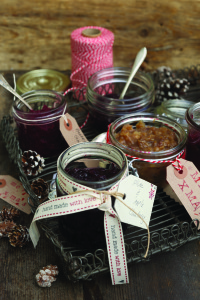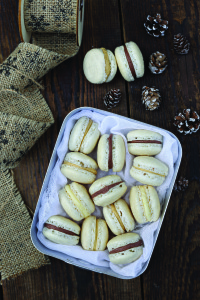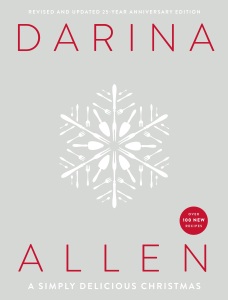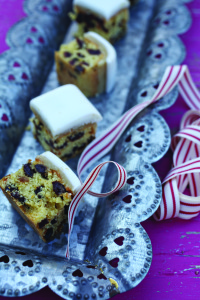- Turkey, Orzo, Pea and Spring Onion Broth
- Christmas Couscous Salad with Pomegranate Seeds and Pistachio Nuts
- St Stephen’s or Boxing Day PieÂ
- Cheddar Cheese and Ham Bread Pudding
- Tostadas
- Mincemeat and Apple Meringue Tart
- Serves 10-12 A wonderful Christmassy Tart and also a particularly good way to use up leftover mincemeat. The pastry is made by the creaming method so people who are convinced that they suffer from ‘hot hands’ don’t have to worry about rubbing in the butter. Use it for a variety of fruit tarts. It can be difficult to handle when its first made and benefits from being chilled for at least an hour. Better still, if rested overnight. Pastry 175g (6oz) white flour 25g (1oz) caster sugar 10g (1/2oz) icing sugar 1 egg, beaten Filling 450g (1lb) mincemeat – see recipe (p.00) 700g (1 1/2lbs) Bramley apples Meringue 3 egg whites 175g (6ozs) caster sugar Egg wash 1 x 9 inch (23cm) deep tart tin Preheat the oven to 180°C/350°F/Gas Mark 4. First make the pastry in the usual way. Beat the butter and sugar together by hand or in a food mixer (no need to over cream). Add the egg and beat for several minutes. Reduce the speed and mix in the flour. Turn out onto a piece of floured greaseproof paper, flatten into a round wrap and chill. This pastry needs to be chilled for at least 1 hour otherwise it is difficult to handle.
- Mincemeat and Bramley Apple Tart
What is it about leftovers that brings a glint to my eyes? I can think of so many ways to use up tasty bits. You can give them an Asian, Mexican or Middle Eastern twist, or just keep it traditional – all can be delicious. I hate to waste even a scrap of delicious food and can think of a zillion yummy ways to reincarnate it.
If you have some juicy morsels of turkey left over, why not try Christmas Couscous Salad with Pomegranate Seeds and Pistachio Nuts or Boxing Day Pie with lots of fluffy mash on top. Chop up the turkey carcass and pop into a pot with a couple of chunks of onion, carrot, a couple of celery stalks, the green part of leeks and some little bunches of fresh herbs, thyme, parsley stalks, maybe a sprig of tarragon and a few peppercorns, no salt and cover with cold water and simmer for 2 to 3 hours on a low heat to make a delicious turkey broth which can be used as a basis for soup or  Turkey, Orzo, Pea and Spring Onion Broth.
Ham or bacon can of course be used in a myriad of ways, even added to a simple frittata, risotto or scrambled egg. I love cheddar cheese and ham bread pudding which also uses up stale bread and scraps of dry cheese in a delicious moreish way.
Mexican tostadas and quesadillas are a terrific vehicle for all kinds of yummy scraps. Left over cold potatoes can be made into Finca Buenvino Mini Tortillas, see my column on 26th April 2014,  so delicious and moreish that you’ll want to cook potatoes especially to make them.
Brussels sprouts keep well and make great salads as well as soups.
Leftover Ballymaloe mincemeat keeps for years but you may want to try mincemeat and Bramley apple meringue tart. Throw a fistful of leftover cranberries into scones or a fruit or make a delicious tart or pear and cranberry chutney.
Stale bread can be made into breadcrumbs for croque monsieur, French toast and knights of Windsor, of course no apologies need to be made for Panettone or bread and butter pudding.
Left over vegetables make a comforting soup or a vegetable gratin. There’s just no end to the delicious reincarnations you can make that will win compliments for your ingenuity.
All the recipes mentioned here come from Darina Allen’s A Simply Delicious Christmas published by Gill and Macmillan, here are a selection for you to try.
Turkey, Orzo, Pea and Spring Onion Broth
This broth can be the basis of a flavoursome light soup to use up delicious morsels of cooked poultry.
Serves 6
1 litre (1 ¾ pints)well-flavoured turkey, chicken or pheasant stock
pinch of chilli flakes (optional)
50g (2oz) orzo pasta
2 tender stalks celery, finely sliced at an angle
150 – 175g (5 – 6 oz) shredded cooked turkey, chicken or pheasant
110g (4oz) frozen peas
4 – 6 spring onions, sliced at an angle
lots of fresh coriander and/or fresh mint
Bring the stock to the boil; add the orzo, celery and chilli flakes. Cook for approximately 10 minutes or until the pasta is just cooked, add the peas and shredded turkey. Season with salt and freshly ground black pepper. Cook for 3 or 4 minutes, correct the seasoning. Ladle into soup bowls, sprinkle with lots of spring onion and fresh coriander and/or mint.
Christmas Couscous Salad with Pomegranate Seeds and Pistachio Nuts
Serves 2-3
How did we cooks manage before we could access juicy pomegranates?
600g (1 1/4lb) leftover roast turkey, chicken or goose
450ml (16fl oz/2 cups) chicken stock
175g (6oz) couscous
2 tablespoons (2 1/2 American tablespoons) pumpkin seeds
2 tablespoons (2 1/2 American tablespoons) dried cranberries or cherries
2 tablespoons (2 1/2 American tablespoons) golden sultanas
2 tablespoons (2 1/2 American tablespoons) pistachio nuts
salt and freshly ground black pepper
lots of fresh mint leaves
seeds from 1 pomegranate (keep a few back for garnish)
4 heaped tablespoons (5 American tablespoons) yoghurt
pomegranate molasses
Pour the boiling chicken stock over the couscous, cover and allow to plump up until the water has been fully absorbed. Chicken stock gives more flavour but if you haven’t any to hand use boiling water.
Shred the fresh cooked turkey, chicken or goose into bite-size pieces. Put it into a mixing bowl with the pumpkin seeds, dried cranberries or cherries, fat golden sultanas and shelled pistachios. Season generously with salt, pepper and coarsely chopped mint leaves then add the pomegranate seeds.
Fluff up the couscous with a fork, sprinkle lots of coarsely chopped mint leaves and pomegranate seeds over the top, then fold in the dry ingredients and freshly squeezed lime juice. Top with a few dollops of yoghurt, a generous trickle of pomegranate molasses, lots of fresh mint leaves, and a scattering of pomegranate seeds.
Inspired by Nigel Slater.
St Stephen’s or Boxing Day PieÂ
Try to keep some left-over turkey and ham for this delicious pie – it’s the most scrumptious way to use up left-overs and can be topped with fluffy mashed potatoes or a puff pastry lid.
Serves 12
900 g (2lbs) cold organic or free-range turkey meat, including the diced crispy skin
450 g (1lb) cold ham or bacon
30 g (1oz) butter
1-2 teasp. grated fresh ginger (optional)
340 g (12oz) chopped onion
225 g (8oz) flat mushrooms or button if flats are not available
1 clove of garlic
900 ml (30 fl.oz) well flavoured turkey stock or 568ml (20 fl oz) stock and 300 ml/10 fl.oz) turkey gravy
1 tablespoon chopped parsley
1 tablespoon chopped chives
2 teaspoons fresh marjoram or tarragon if available
150 ml (¼ pint) cream
450 g (1lb) puff or flaky pastry or 900g (2lb) Duchesse or mashed Potato
2 x 1.1 L/2 pint) capacity pie dishes
Cut the turkey and ham into 1 inch (2.5 cm) approx. pieces. Melt the butter in a heavy saucepan, add the chopped onions and ginger if using, cover and sweat for about 10 minutes until they are soft but not coloured. Meanwhile wash and slice the mushrooms. When the onions are soft, stir in the garlic and remove to a plate. Increase the heat and cook the sliced mushrooms, a few at a time. Season with salt and freshly-ground pepper and add to the onions and garlic. Toss the cold turkey and ham in the hot saucepan, using a little extra butter if necessary; add to the mushrooms and onion. De-glaze the saucepan with the turkey stock. Add the cream and chopped herbs. Bring it to the boil, thicken with roux, add the meat, mushrooms and onions and simmer for 5 minutes. Taste and correct the seasoning.
Fill into the pie dishes, and pipe rosettes of potato all over the top. Bake in a moderate oven, 190C/375F/regulo 5, for 15-20 minutes or until the potato is golden and the pie is bubbling.
Alternatively, if you would like to have a pastry crust, allow the filling to get quite cold. Roll out the pastry to about 1/8-inch (3 mm) thickness, then cut a strip from around the edge the same width as the lip of the pie dish. Brush the edge of the dish with water and press the strip of pastry firmly down onto it; wet the top of the strip again. Cut the pastry into an oval just slightly larger than the pie dish. Press this down onto the wet border, flute the edges of the pastry with a knife and then scallop them at 1 inch (2.5 cm) approx. intervals. Roll out the trimmings and cut into leaves to decorate the top. Make a hole in the centre to allow the steam to escape while cooking.
Brush with egg wash and bake in a preheated oven, 250C/475F/regulo 9, for 10 minutes; then turn the heat down to moderate, 180C/350F/regulo 4, for 20-25 minutes or until the pastry is cooked through and the pie is bubbling.
Serve with a good green salad.
Cheddar Cheese and Ham Bread Pudding
Bread and Butter pudding can be sweet or savoury, try this one, even just with cheese, but if you have a little cooked ham or bacon it’s even better, it makes a tasty economical supper for 3 or 4 hungry people.
Serves 6
50g (2oz) very soft butter (for buttering the bread and greasing the dish)
6 slices of good white bread (1-2cm/½-¾ inch thick approx.), crusts removed – about 100g (3½oz) prepared weight
110g (4oz) mature Cheddar, coarsely grated
175- 225g (6-8oz) cooked ham, diced in 7mm (â…“ inch) cubes approx.
3 medium free-range eggs
450ml (16fl oz) milk
3-4 teaspoons thyme leaves, chopped
A generous pinch of mace
1½ teaspoons Dijon mustard
salt and freshly ground black pepper
1 litre (1¾ pint) ovenproof soufflé dish.
Grease the soufflé dish with soft or melted butter.
Then butter slices of bread and cut into roughly 2.5cm (1inch) squares. Put into the dish, add the grated cheese and ham and toss to combine.
Whisk the eggs well. Add the milk, thyme leaves, mace and Dijon mustard and continue to whisk for a minute or two. Season well with salt and freshly ground black pepper. Pour over the bread, cheese and ham mixture. Cover and pop in the refrigerator for a couple of hours or even overnight.
The next day, preheat the oven to 180°C/350°F/Gas Mark 4 and bake the soufflé for 40 minutes or until puffed up and golden like a soufflé.
Serve with a green salad.
Tostadas
Another great way to use up leftover turkey chicken, guinea fowl or pheasant, you’ll be wishing you cooked a bigger turkey.
Tostadas are a favourite snack in Mexico, the filling varies according to the area, it can be beef, chicken, pork, turkey, crab or just vegetables. The filling is always piled high so Tostadas are always quite a challenge to eat elegantly but what the heck they taste delicious!
Serves 8
8 tortillas, they ought to be corn tortillas but wheat flour tortillas can be substituted.
225g (8ozs) refried beans, optional
1/2 iceberg lettuce, shredded
110-175g (4-6ozs) cooked turkey or chicken breast or leg, shredded
1 sliced chilli, optional
4 very ripe tomatoes, sliced
1 avocado or Guacamole
4 tablespoons spring onion
3 tablespoons sour cream
50-110g (2-4ozs) grated Cheddar cheese
Sea salt
Deep fry the tortillas in hot oil until crisp and golden, drain on kitchen paper. Put each tortilla on a hot plate, spread with a little warm refried beans and then top with some crunchy lettuce, shredded chicken breast, guacamole and so on.
Finish off with a blob of sour cream and a sprinkling of cheddar cheese and a few chives. If you don’t have refried beans to hand, just omit them. The tostadas will still be delicious.
Serve immediately.  In Mexico Tostadas are considered to be finger food – you’ll need both hands!
Mincemeat and Apple Meringue Tart
Serves 10-12
A wonderful Christmassy Tart and also a particularly good way to use up leftover mincemeat.
The pastry is made by the creaming method so people who are convinced that they suffer from ‘hot hands’ don’t have to worry about rubbing in the butter. Use it for a variety of fruit tarts. It can be difficult to handle when its first made and benefits from being chilled for at least an hour. Better still, if rested overnight.
Pastry
175g (6oz) white flour
25g (1oz) caster sugar
10g (1/2oz) icing sugar
1 egg, beaten
Filling
450g (1lb) mincemeat – see recipe (p.00)
700g (1 1/2lbs) Bramley apples
Meringue
3 egg whites
175g (6ozs) caster sugar
Egg wash
1 x 9 inch (23cm) deep tart tin
Preheat the oven to 180°C/350°F/Gas Mark 4.
First make the pastry in the usual way. Beat the butter and sugar together by hand or in a food mixer (no need to over cream). Add the egg and beat for several minutes. Reduce the speed and mix in the flour. Turn out onto a piece of floured greaseproof paper, flatten into a round wrap and chill. This pastry needs to be chilled for at least 1 hour otherwise it is difficult to handle.
Bake the tart base blind for about 25 minutes in the preheated oven or until pale and golden, remove the beans and paper.
Brush the prebaked tart shell with a little beaten egg and pop back into the oven for 5-minutes or until almost cooked. Cool. Reduce the temperature to 130ºC/250ºF/Gas mark 1/2.
Peel and core the apples. Cut into 1 inch (2.5cm) chunks. Place in a sauté pan with a tight fitting lid. Put on a very low heat and cook until the apples have broken down 25- 30 minutes approx. It should be tart to counteract the sweetness of the mincemeat and meringue.
Whisk the egg whites with the caster sugar until it reaches stiff peaks. Spread the apple puree over the cooked pastry base, spoon the mincemeat over the apple. Top with the meringue fluffing into peaks. Return to the oven and cook for 1 hour until the meringue is crisp. Cool on a wire rack and serve with a bowl of softly whipped cream.
Mincemeat and Bramley Apple Tart
Omit the meringue and just cover the tart with another layer of pastry, decorate with stars, holly leaves and berries, or whatever takes your fancy. Brush with egg wash and bake.
Hot Tips:
The Lettercollum Cookbook. Karen Austin has published her much anticipated cookbook of Lettercollum recipes at last. It is mostly vegetarian but her delicious weekly fish dinners have also slipped in. Karen Austin and Con McLoughlin occasionally enjoy a little chorizo with their beans so these are also included. A charming book with photos by Arna Rún Rúnarsdóttir. The Lettercollum Cookbook was published by Onstream.
It’s the Little Things, Francis Brennan’s Guide to Life. Francis Brennan is terrifically good company, erudite and witty with a razor sharp eye for detail. His new book is a guide to modern manners  and etiquette. A timely reminder at a time when many have forgotten the joy of sitting around the kitchen table with family and friends not to speak of how to fold napkins, interact with waiting staff or arrange the towels for guests. A best seller over the Christmas season.





